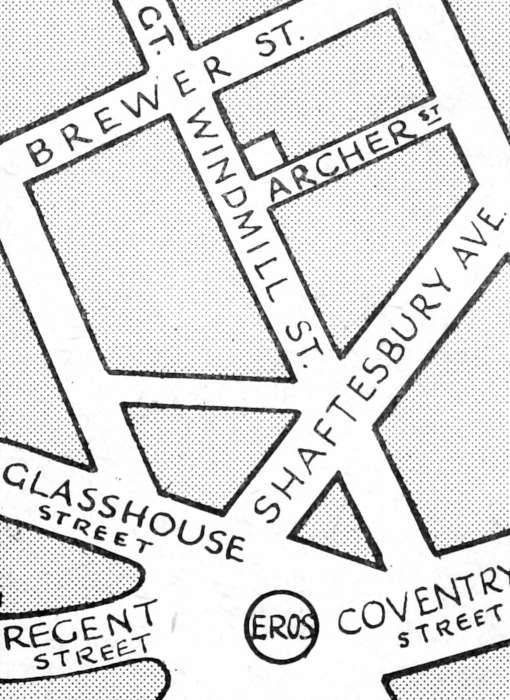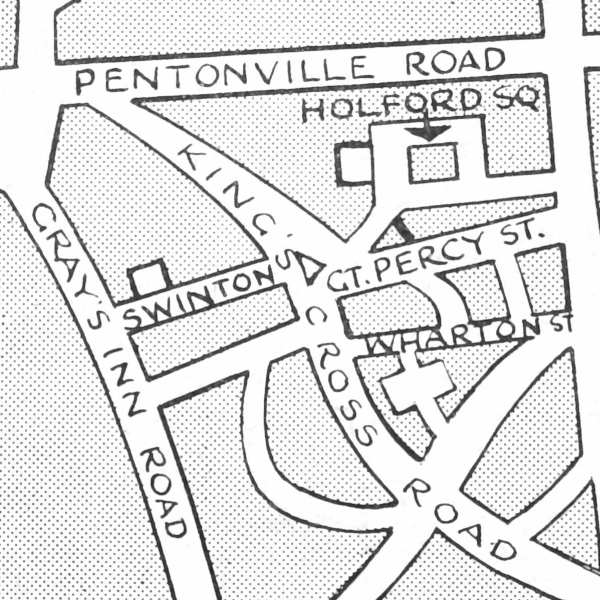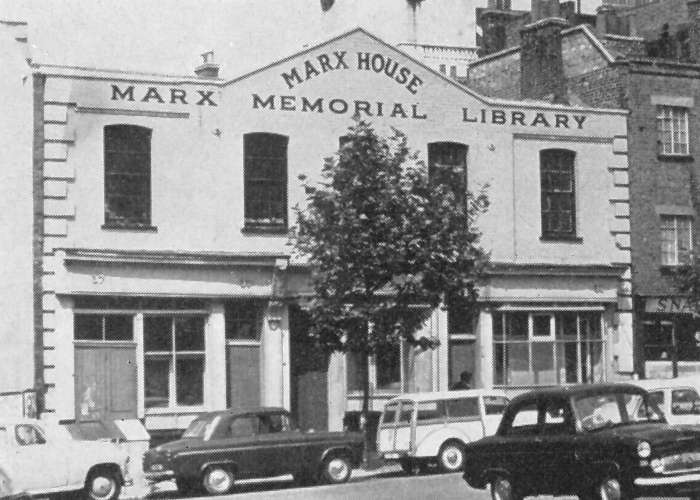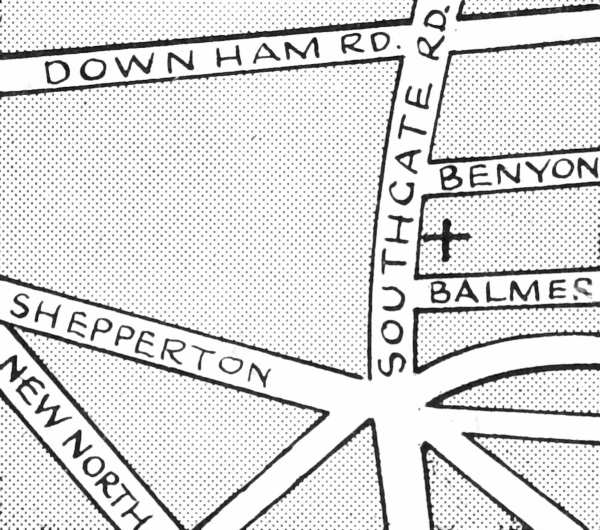London, as the capital city for a thousand years, has a deep and intimate connection with all the struggles of the working people of England from the earliest times.
London in 1381 saw the triumph and the tragedy of the great Peasant Rising led by John Ball and Wat Tyler, which the London poor joined when the peasants reached the capital and threw open its gates to them. Smithfield, now the Central Meat Market, was the scene of the treacherous murder of Wat Tyler by the Court nobles and the Lord Mayor. Here took place many struggles of the London porters and other guilds of the London working class in the days of manufacture. Here in the days of the English Revolution, King Charles lost his head on the scaffold in Whitehall; here the London workers supported, in the eighteenth century, the Wilkes and Liberty movement and early radical reform struggles against the iniquitous Newspaper Tax; here were some of the great days of the Charter movement in the 1830s and 1840s; here mass struggles in the 1860s helped to secure the vote for the first time for a section of the working class in the first Socialist party in this country—the Social Democratic Federation—was formed in 1884; the great unemployed struggles took place at the end of the 80s, and the “new unionism”—the trade unions of the dockers, gas workers and other mass occupations—came into existence.
Marx, Engels and Lenin moved and worked in London, and saw some of the later developments. Our object is not to write a history of these but to give to the present generation a guide to the places of interest associated with the lives of these greatest thinkers and leaders of modern times. Marx and Engels drew on much of the experience of the London workers as well as on the experience of British capitalism as a whole, which Marx studied in the British Museum, to build the theory and practice of scientific socialism and communism.
Lenin, developing their theory and practice, had his personal experience of life among the London workers as well as the riches of the British Museum; and when the Bolshevik Party, with Lenin at its head, led the Russian workers for the first time in history, to the overthrow of capitalism and the laying of foundations for socialist society, no socialist movement in the world declared its support for the October Revolution earlier than the British Socialist Party, successor of the SDF centred in London.
It was at the Memorial Hall, Farringdon Road, that on February 27th 1900, British organised labour took a historic step forward, by setting up the Labour Party (in the same hall, 26 years later, the General Strike was decided on).
In publishing this booklet, we desire to acknowledge our debt to the work done by James Shields and Eileen Palmer, who first produced London Landmarks, on the occasion of the centenary of the Communist Manifesto, for publication by the Communist Party.
Since the brochure was first published in 1948, however, new and detailed information has come to hand which in parts corrects the first edition and adds further to our knowledge. We pay a tribute in this connection to valuable research on these matters conducted by the Marx Memorial Library, the Institute of Marxism-Leninism in Moscow, and a number of individuals.
Communist League Hall
Great Windmill Street

The first visit of Marx to London was in 1845, when on Engels’ invitation he came here as part of a six-week journey. He next came to London in November 1847, when he attended the Second Congress of the Communist League. It was at this Congress that Marx and Engels were commissioned to draw up the Manifesto.
The Congress, which lasted from November 29 to December 8, took place in the hall of the Communist League, or the Communist Workers’ Educational Union, which was then situated at 20 Great Windmill Street. In the years 1850-51, when Marx was resident in London, he gave a Course of Lectures in Economics in this building.
Great Windmill Street is a short street running from Coventry Street, Piccadilly Circus end, northwards to Brewer Street. The Communist League Hall is believed to have been situated in the upper part of the building which is now the Red Lion public house, but information as to what was its exact location is indefinite.
The first edition of the Manifesto of the Communist Party was printed at 46 Liverpool Street, Bishopsgate, London.
Whilst in London in 1847, Marx also addressed a meeting of the German Workers’ Society in their hall in Drury Lane, situated in the Whyte Hart Inn. The Whyte Hart Inn still stands on the same spot at the corner of Drury Lane and High Holborn.
Residence in Chelsea
Marx was 31 years of age when in August 1849, he took up his residence in London.1 At that time he had three children, two girls and a boy. The family joined him about five weeks later, and settled down in lodgings in Chelsea at 4 Anderson Street, London, SW3. The house is still standing—unaltered. It was here that his fourth child Henry was born.
The Marx family lived in Chelsea from October 1849 until April 1850. At this time the family were experiencing extreme poverty. During his stay in this part of London, Marx edited the six issues of the resuscitated Neue Rheinische Zeitung. From these lodgings the Marx family were suddenly and cruelly evicted. In one of her letters, Mrs. Marx relates the circumstances of this eviction, telling how the landlady suddenly repudiated an arrangement which they had made with her and demanded £5 rent which was then owing, and which Marx at that moment did not possess. Seizure of the furniture and family possessions was threatened, but through the help of a friend the money was raised. However, the beds had to be sold to meet the pressing demands of the chemist, butcher, baker and milkman. Next day the family moved from the Chelsea area.
Stay in Leicester Street
From Chelsea, Marx and his family moved to the temporary shelter of the German Hotel at 1 and 2 Leicester Street, adjoining Leicester Square. On the site of the German Hotel now stands the Monte Carlo Hotel, a five-storey building at the corner of Leicester Street and Lisle Street. Marx lived here in April and May 1850.
Marx’s family move
to Dean Street

The Marx family moved in May 1850, first to 64 Dean Street, Soho,2 where they lived from May 8 until December 2, and then to № 28 Dean Street, Soho, occupying two small rooms on the first floor of this building. Since that time, the ground floor has been completely altered, and now houses the Quo Vadis Restaurant. It was whilst staying in Dean Street that Marx wrote many of the articles collected in his famous Eighteenth Brumaire (1852), Herr Vogt, The Class Struggles in France, 1848-1850 in 1850, The Eastern Question, and helped Frederick Engels in writing a series of articles for the New York Daily Tribune, which afterwards were published under the title Germany, Revolution and Counter-Revolution. The greater part of Capital was also written by Marx during his residence here. Whilst in Dean Street, the fifth child, Francisca, was born in 1851. Both his fourth child Henry3 and his fifth child Francisca died here in 1852. The family lived here from December 1850 until September 1856.
Liebknecht’s residence
in Romilly Street
Wilhelm Liebknecht, who came to London in June 1850, took up residence at № 14, Church Street, only a short distance away from Dean Street where Marx lived. The name of the street has now been changed to Romilly Street. On the site of № 14 where Liebknecht lived there is now a large five-storey building containing the premises of William Page & Co. Ltd. 75 years earlier, Jean Paul Marat, the mightiest figure of the great French Revolution, lived in this street.
In 1856 the last child, Eleanor ‘Tussy’ was born, she became famous later as a socialist speaker and writer. In the same year, Marx lost his third child and only surviving son, Edgar.
Whitefield’s Churchyard
in Tottenham Court Road
The three children, Henry, Francisca and Edgar, were buried in the churchyard of Whitefield’s Memorial Church, “Whitefield’s Tabernacle” in Tottenham Court Road.4 The old Tabernacle was completely destroyed during the Second World War by a flying bomb, but part of the little churchyard can still be seen there.
There can be little doubt that the death of Marx’s children was largely due to the terrible hardship and poverty which the Marx family were experiencing at this time. For years Marx lived in the most severe financial straits.
Engels’ residence
at Macclesfield Street
Frederick Engels first visited England in November 1842, two months after completing his period of military service in Germany. He came to take up the position of clerk in the offices of Ermen and Engels in Manchester, a firm in which his father was a partner. On his way to England on this occasion, he called in at the offices of Neue Rheinische Zeitung in Cologne, where he met Marx for the first time. The two men, however, only became really acquainted personally in 1845, when Engels visited Marx in Brussels. Engels’ first visit to England lasted for a period of 21 months.
Subsequently, during the time Marx was residing at Dean Street, Engels was living at № 6 Macclesfield Street, just off what is now called Shaftesbury Avenue (see map). The building in which Engels lived was afterwards demolished and a new building later erected on the site. The site of the house in which Engels resided is now occupied by Gino’s Cafe, in a building adjoining Dansey Place.
Marx, Lenin and the British Museum
Both Dean Street and Macclesfield Street5 are about ten minutes’ walk from the British Museum, situated at Great Russell Street. Marx spent a great deal of his time conducting research here in the reading room. Later in 1902-3, Lenin also became a regular visitor to the Museum Reading Room, and in May 1908 specially visited it in order to procure material which he required in connection with his famous book on Materialism and Empirio-criticism.
From where Marx and Engels lived in Soho, to the corner of King Street and Bedford Street, the present headquarters of the Communist Party are present only a short walking distance away in Covent Garden. The nearest tube station for this area is Leicester Square.
Denmark Road
Camberwell
In 1855, Marx resided for a short period from the beginning of September until the end of November at 3 York Place, Denmark Road, Camberwell. He lived here in the flat of a friend named Inmandt, who loaned it to him for the period whilst he was on holiday in Montrose. When Imandt returned from his holiday, Marx returned to Dean Street.
Marx moves to Grafton Terrace
Kentish Town
In October 1856, Marx left the Soho area and moved to 9 Grafton Terrace, Fitzroy Road, Kentish Town. Some time later the entire street was renamed Grafton Terrace, and in the renumbering of the houses Marx’s dwelling became № 46 Grafton Terrace. It was while living here that Marx’s wife Jenny contracted smallpox, from which she happily recovered. The family lived here until March 1864. Here Marx wrote his Critique of Political Economy (1859), many paper collected later as Theories of Surplus Value (Vol. IV of Capital) and many political articles.
The house in Maitland Park Road

From Grafton Terrace the family moved in March 1864, to № 1 Modena Villas, renamed in 1868 to 1 Maitland Park Road—when Modena Villas, Maitland Park Road, Maitland Park Villas and Maitland Park Crescent6 were amalgamated as Maitland Park Road. Dr. Edward Aveling, who married Marx’s youngest daughter, Eleanor, lived opposite at № 67. Marx’s eldest daughter, Jenny, was married to Charles Longuet. His second eldest daughter, Laura married Paul Lafargue. Here Marx wrote the Inaugural Address of the First International, completed Vol. I of Capital (1867) and wrote The Civil War in France (1871).
In March, 1875, Marx moved to № 41. It was here that Marx’s wife died on December 2nd 1881, followed by the death of Marx himself on March 14th 1883. The house no longer exists: the whole street suffered badly from a blast during the war, and today a block of LCC flats stands on the site. Here Marx wrote his Critique of the Gotha Programme (May 1875).
Family grave
at Highgate Cemetery
Marx, his wife Jenny, his grandson Harry Longuet, and the faithful servant-companion of the Marx family, Helena Demuth, were all buried in Highgate Cemetery. This cemetery is a few minutes’ walk from either Archway Underground Station, Highgate, or the bus terminus at Parliament Hill Fields.7
On March 14th 1956, a monument to Karl Marx, erected by international subscription, was unveiled in Highgate Cemetery by Harry Pollitt. This monument stands in a commanding position, higher up in the cemetery from the place where the remains of the Marx family were originally buried. These have been transferred and reinterred, together with the urn containing the ashes of Eleanor Marx Aveling, which stood for many years in the premises of the Central Committee of the Communist Party of Great Britain.
The simple headstone which formerly marked the grave, and which has now been incorporated in the new monument, bears the inscription:
JENNY VON WESTPHALEN
The beloved Wife of
KARL MARX
Born 12 February 1814 Died 2 December 1881
and
KARL MARX
Born 5 May 1818 Died 14 March 1883
and
HARRY LONGUET
their Grandson
Born 4 July 1878 Died 20 March 1883
and
HELENA DEMUTH
Born 1 January 1823 Died 4 November 1890
and
ELEANOR MARX AVELING
Born 1856 Died 1898
The site of the original grave has been suitably marked.
Among the many distinguished visitors to London who have visited Marx’s grave since the end of the war were leading statesmen and Communist Party leaders from the socialist countries, together with workers from these and almost all other lands.
A few yards distant from the original grave is buried Dushar Popovitch, a Serbian revolutionary socialist, who was the first translator of Marx’s Capital into the Serbian language, and took up an outstanding internationalist position during the First World War. It was during one of the commemoration ceremonies at Marx’s grave, which are held annually on the date of his death, March 14, that Yugoslavs who were in exile in Britain during the Second World War became aware of this last resting place of their fellow countryman.
Almost opposite the Marx Monument is buried the Liberal philosopher, Herbert Spencer—who declared that socialism meant slavery! On the same side of the path, but further up, are buried Mary Anne Cross (George Eliot), the great novelist and leading atheist in the nineteenth century, her husband, George Henry Lewes (historian of philosophy) and George Jacob Holyoake, Chartist in his early years and later campaigner for co-operation.
Where Engels lived
at Primrose Hill
During the time Marx was living at Maitland Park Road, Engels lived (from September, 1870 to October 1894) at 122 Regents Park Road, opposite Primrose Hill. From October 1894, until his death in August 1895, he lived at № 41 in the same road, near St. Mark’s Church, which is only a stone’s throw away from the Zoological Gardens in Regents Park (see map). Engels wrote many of his famous works at № 122—The Housing Question (1872), Anti-Duhring (1877-78), the revised form of three chapters of this book published as Socialism, Utopian and Scientific (1880), Origin of the Family, Private Property and the State (1884), Ludwig Feuerbach (1888). Whilst Engels was living there, he used regularly to take the short quarter-of-an-hour’s walk over Primrose Hill to Marx’s residence in Maitland Park Road.
St. Martin’s Hall, Long Acre
and the First International
The International Working Men’s Association, the First International, of which Marx was the inspiration and guiding genius, was founded on September 28th 1864 at a meeting in St. Martin’s Hall, Long Acre. The site where St. Martin’s Hall stood in Long Acre is now occupied by Odham’s Press. The nearest tube station for this area is Covent Garden. From October 1864 to January 1866, the General Council of the International met at № 18 Greek Street (see map).
Lenin’s first visit
to London

Lenin first arrived in London in April 1902. In Memories of Lenin, Lenin’s wife Krupskaya relates how he studied the city. “He loved going on long rides about the town on top of an omnibus. He liked the movement of the huge, commercial city. ‘The quiet squares, the detached houses, with their separate entrances and shining windows, adorned with greenery, the drives frequented only by highly polished broughams were much in evidence—but tucked away nearby were the mean little streets, inhabited by the working people, where lines of washing hung across the street, and pale children played in the gutter—sights which could not be seen from the bus top. In such districts we were on foot, and observing these howling contrasts of richness and poverty, Ilyich would mutter through clenched teeth and in English: ‘Two Nations’.”
The house
in Holford Square

Lenin and Krupskaya set up house in two rooms situated on the first floor of № 30, Holford Square, and stayed there until the beginning of May 1903. This Square is situated in the borough of Finsbury, about 10 minutes’ walk from King’s Cross Station. The house where Lenin lived was destroyed in the early bombing raids during the Second World War. Opposite the house, a Memorial to Lenin erected by the Finsbury Borough Council was unveiled by the Soviet Ambassador Mr. Maisky, on Lenin’s birthday, April 22 1943. On the house itself, Mr. Maisky unveiled a plaque of commemoration to Lenin, which was placed there by the London County Council in 1942. It is now placed in the Finsbury Town Hall. For a short time, in 1905, when attending the Third Congress (see below) Lenin lived at № 16 Percy Circus.
The Crown and Woolpack
in Finsbury
About five minutes’ walk from Holford Square stands the Crown and Woolpack public house in St. John’s Road, about a hundred yards west of City Road. One of the rooms on the upstairs floor was used occasionally for meetings by Lenin and his comrades. It was here that the police detective who afterwards became one of the Scotland Yard chiefs, secreted himself in a cupboard on one occasion to listen-in to what was being said. However, the conversation being conducted in the Russian language, of which the police officer was ignorant, left him no wiser.
Marx House
in Clerkenwell Green
Another place of interest in this part of London is 37/38 Clerkenwell Green, just off Clerkenwell Road and Farringdon Road, where the Marx Memorial Library is now situated. It was in this building that Lenin with Harry Quelch, editor of Justice, worked on material for Iskra, which was set up at a little Russian printer’s in the East End and printed on a flat-bed machine at Clerkenwell Green.
A few hundred yards away from Marx House is the Daily Worker building on Farringdon Road.

Early London associations
of the Bolshevik Party
London has associations of particular interest to the Bolshevik Party as three of its early Congresses were held in the city. These include: the famous Second Congress of the RSDLP in July-August 1903, the Third Congress in May 1905, and the Fifth Congress in May 1907.
There is doubt as to the exact place in which the Second and Third Congresses were held. The Second Congress began in Brussels, and was transferred to London in August 1903: its first session here is believed to have been held in a hall used by an Anglers’ Club on Charlotte Street, Tottenham Court Road. On May 1 1903, Lenin was announced in Justice as the first speaker from the “Continental Platform” at the May Day demonstration to be held that day at Alexandra Palace, in North London. No report of his speech has yet been found, and it is not quite certain, therefore, that he did speak—although he was extremely punctilious about such engagements. However, there is no doubt as to the place where the Fifth Congress in 1907 was held, namely, the Brotherhood Church on Southgate Road, Islington. This church was run by a Socialist parson.
The Brotherhood Church

Southgate Road is situated on the borders of Islington and Dalston and Hackney, between Balls Pond Road and the junction of Shepperton and Hyde Roads. The Brotherhood Church (since demolished) was situated at the southern end of Southgate Road on the corner of Balmes Road, between 24a and 30 Southgate Road. The site of the Brotherhood Church, is now occupied by a modern factory opposite Champion Druce’s Lead Mills. After the church closed down, a tablet which recorded the visit of Lenin was sent to the Soviet Ambassador Ivan Maisky.
The Communist Club
Marx, Engels and Lenin all visited the German Workers’ Educational Society, founded by emigrant German workers in the 1840’s, and known in its later years as the “Communist Club”, when it was situated at 107 Charlotte Street, W1.8 The Bolshevik group in London after 1905, of which the secretary was Maxim Litvinov, regularly used this club for meetings. The club was closed down in 1918, after more than 70 years’ existence, following police raids during the First World War.
Appendix—Engels in Manchester
| November 1850—September 1852 | 70 Great Ducie Street, Strangeways |
| October 1852—1858 | 48 Great Ducie Street 34 Butler Street, Greenheys |
| 1858—1860 | 6 Thorncliffe Grove, Oxford Road |
| 1860—1862 | 252 Hyde Road |
| 1862—1864 | Tennant Street (number unknown) |
| 1864—1870 | 86 Mornington Street, Stockport Road, Ardwick |
Notes
1 His passport, a copy of which hangs in the Marx Memorial Library, shows that he embarked at Boulogne on August 26.
2 This building has since been demolished.
3 Born on November 5, 1849.
4 Near where Goodge Street tube station now stands.
5 Macclesfield Street is a continuation of Dean Street.
6 All gradually developed out of a private estate, Maitland Park (the gateway to the estate is still there).
7 The Marx family often spent the day on holiday occasions at Parliament Hill Fields, or some other part of Hampstead Heath, which Parliament Hill Fields adjoins.
8 The building was destroyed by a German bomb during the blitz in 1940.